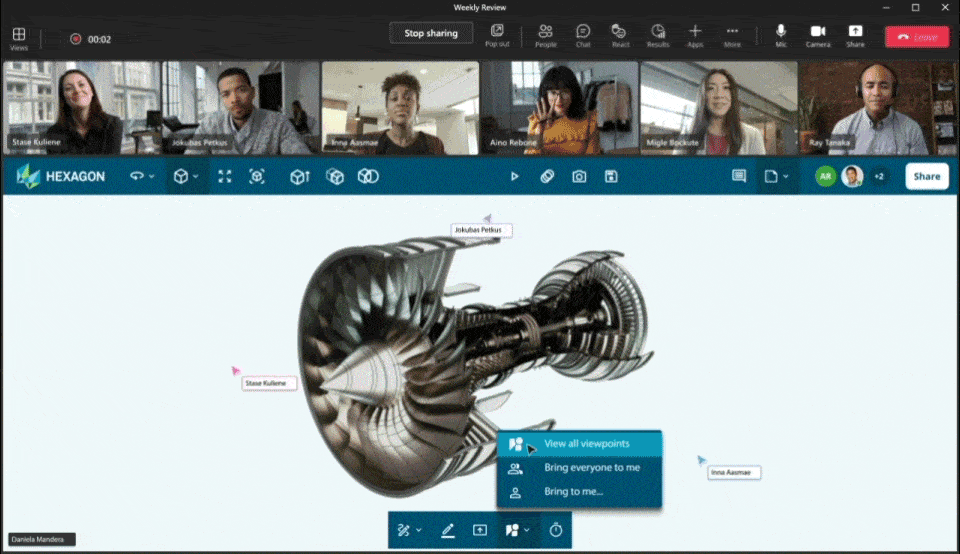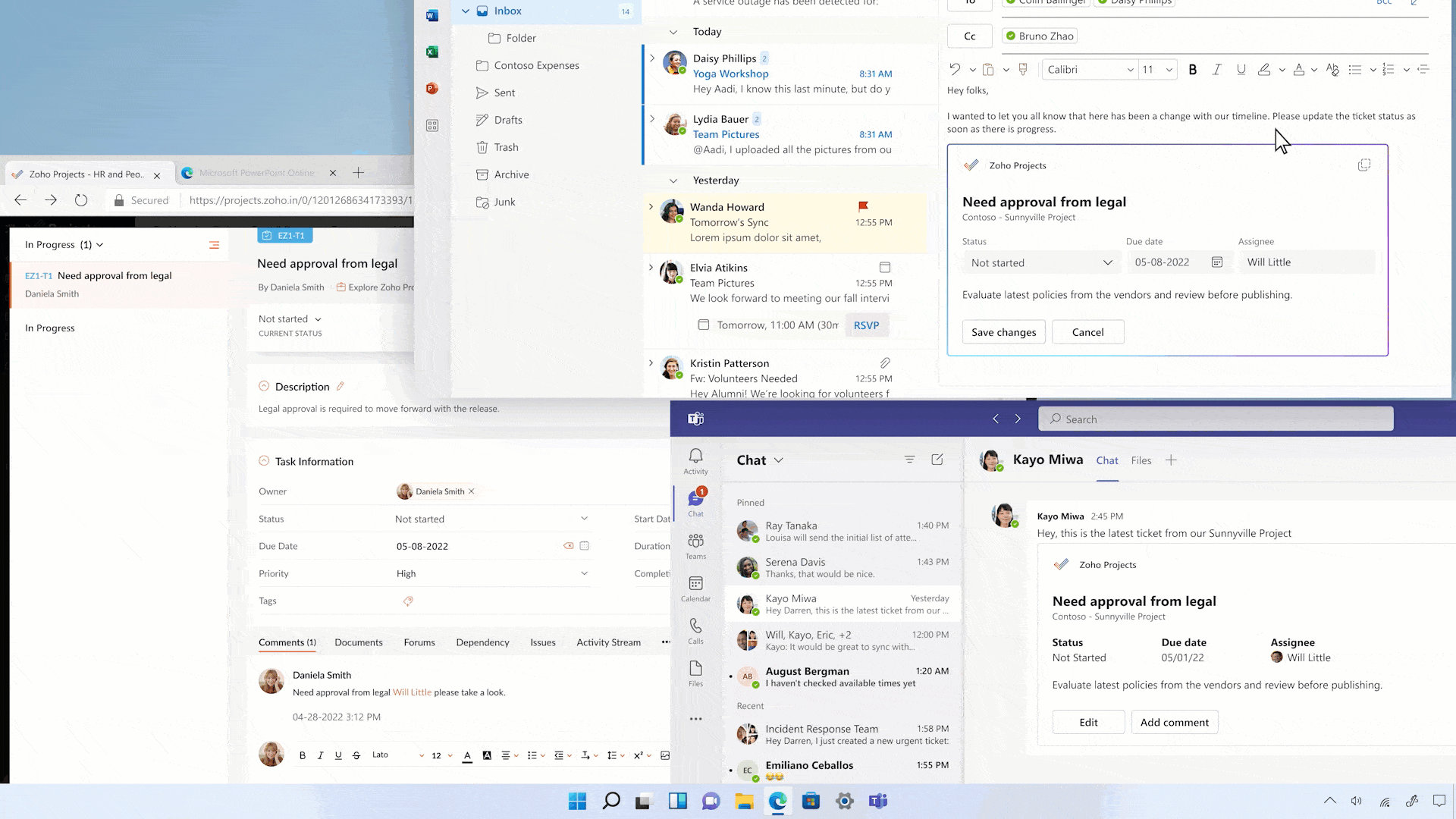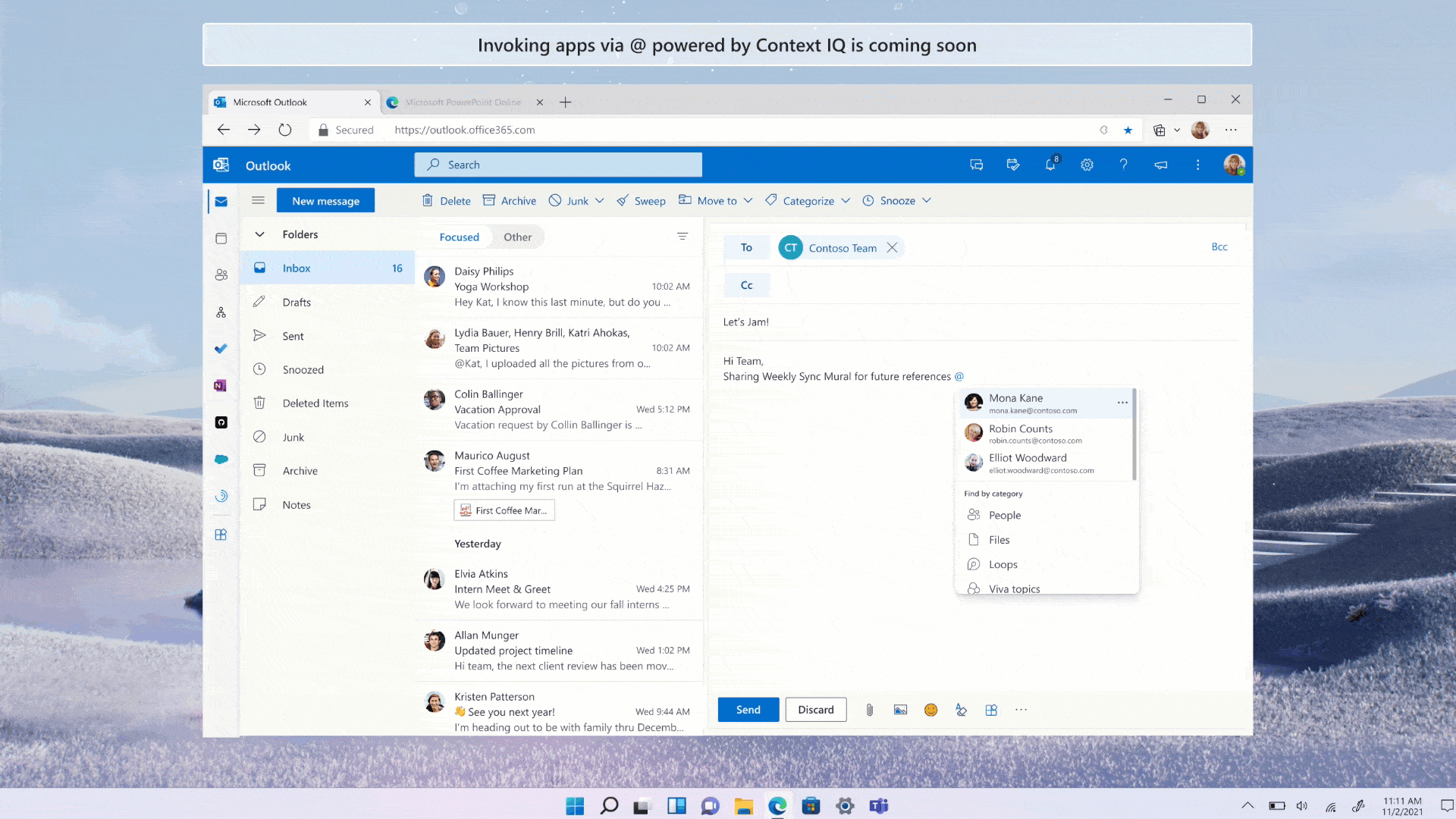
コラボレーティブ アプリを Microsoft Teams とともに構築する
このパンデミック (感染症の世界的な大流行) で、ハイブリッド ワークのコア イネーブラーとしてのテクノロジの役割が劇的に加速しており、開発者はこの変革の中心に立っています。前回の Microsoft Build でコラボレーティブ アプリを発表しましたが、この新しいアプリ パターンのねらいは、ユーザーがハイブリッド ワークプレイスで成功を続けていけるように人、プロセス、データをひとつにまとめることです。人々がソフトウェアを消費する方法がモバイル デバイスによって完全に変革したのと同じように、コラボレーティブ アプリはあらゆる組織での人々の共同作業の方法を変革していきます。
月間アクティブ ユーザー数 2.7 億を超える Microsoft Teams は開発者に、コラボレーティブ アプリ構築という他にはない機会を提供しています。2020 年初頭に比べて、Teams 内のカスタム構築またはサードパーティのアプリの月間アクティブ ユーザー数は 10 倍以上に増加しています。Teams 対応アプリの数は 1,400 を超え、ますます多くの独立系ソフトウェア ベンダー (ISV) が、Teams と Microsoft 365 のサービスを基盤とするアプリを開発してそのユーザーからの多額の年間収益を生み出しています。将来に目を向けると、今後登場するテクノロジがデジタルと物理の世界をひとつにまとめると考えられます。その一例が Microsoft Mesh for Teams ですが、こうして Teams でのコラボレーティブなエクスペリエンスに参加する新しい機会が開かれることが期待されます。
今年の Build 2022 では、Teams と Microsoft 365 に対応するコラボレーティブ アプリ開発に関する多数の新機能と機能強化を発表しています。私と Charles Lamanna の基調講演「Innovate with collaborative apps and low code」(イノベーションをコラボレーティブ アプリとロー コードで) でハイライトをご覧ください。このブログでは、Build での発表の要約を 3 つのセクションに分けて紹介します。ユーザーを満足させる豊かなコラボレーティブ エクスペリエンス、開発者の生産性拡張とユーザー エンゲージメントの増大、そしてアプリの収益化です。これらのイノベーションを使って皆さまがどのようなものをビルドされるのか、非常に楽しみです!
ユーザーを満足させる豊かなコラボレーティブ エクスペリエンス
Live Share のご紹介: Teams 会議の中での対話型アプリ エクスペリエンス
このたび発表する Live Share は、開発者が作成するアプリで受動的な画面共有だけでなく参加者の共同視聴、共同編集、共同作成などを Teams 会議の中で実現するための機能です。Teams SDK の新しい拡張機能 (プレビュー中) を使用して簡単に、既存の Teams 向けアプリを拡張して会議の中に Live Share エクスペリエンスを作り出すことができます。Live Share を支えている "流動フレームワーク" は、状態、メディア、コントロール アクションの高度な同期をサポートするものであり、必要な開発はフロントエンド側のみです。 この同期は、Teams によってホストされ管理される Microsoft Azure Fluid Relay サービス インスタンス上で実行されますが、利用料金は発生しません。Frame.io、Hexagon、Skillsoft、MakeCode、Accenture、Parabol、Breakthru などのパートナー各社が既に Live Share エクスペリエンスを構築しています。Live Share のオンデマンド セッションをご覧になり、新しい Teams SDK 拡張機能をお試しください。

図 1. Hexagon の Live Share プロトタイプを使って、エンジニアたちが Teams 会議の中でブレーンストーミングしながら 3D のモデルとシミュレーションに注釈を付けたり、編集したりしています。
流動フレームワークと Azure Fluid Relay の一般提供
流動フレームワーク (Fluid Framework) はオープンソースのクライアントサイド JavaScript ライブラリの集合であり、Live Share のリアルタイム コラボレーション機能を支えています。Azure Fluid Relay は、流動フレームワーク クライアントをサポートする完全マネージド型のクラウド サービスです。開発者は流動フレームワークと Azure Fluid Relay を使用して、開発するアプリでのリアルタイムの対話を Microsoft Teams 会議以外の場所でも実現することができます。流動フレームワーク、Azure Fluid Relay サービス、そしてこれに対応する Azure Fluid クライアントサイド SDK が実稼働シナリオへの準備を整えて提供を開始するのは 2022 年中盤の予定です。最新情報については Microsoft Developer Blogs をご覧ください。こちらのオンデマンド セッションで、流動フレームワークと Azure Fluid Relay を使用するコラボレーティブ Web アプリの構築についてさらに学ぶことができます。
アダプティブ カードを更新して Loop コンポーネントを作成
Microsoft Loop コンポーネントはライブの、アクション実行可能な生産性単位であり、常に同期を保って Microsoft 365 のアプリ間を自由に移動します (最初は Teams チャットと Microsoft Outlook)。本日、開発者が Loop コンポーネントを作成できるようになりましたことを発表します。これで、簡単に既存のアダプティブ カードを Loop コンポーネントに進化させることや、新しいアダプティブ カード ベースの Loop コンポーネントを作成することができるようになります。加えて、アダプティブ カード ベースの Loop コンポーネントを "エディター" の画面に表示することができます。これに使用される Context IQ はインテリジェントな機能の集合であり、Microsoft のアプリやサービスのバックグラウンドで稼働するので、ユーザーはメール新規作成の流れを止めずに続けることができます。Zoho Projects はこのアダプティブ カード ベースの Loop コンポーネントを利用して、同社の顧客のインシデント応答時間を向上させてサービス停止時間を短縮するとともに SLA (サービス レベル アグリーメント) を基準とする全体的なパフォーマンスを高めるためにユーザーがこれらのタスクを Teams でも Outlook でも実行できるようにしています。Zoho Projects と ServiceDesk Plus Cloud はいち早く Microsoft 365 のアプリと統合して Microsoft Loop を実装した製品の例です。この機能の開発者プライベート プレビューは 2022 年 6 月に開始します。最新情報については、Microsoft Developer Blogs をご覧になるか Twitter で @Microsoft365Dev をフォローしてください。

図 2. Zoho Projects はアダプティブ カードをライブの、アクション実行可能な Loop コンポーネントに発展させて Teams と Outlook の両方で動作するようにしました。
Microsoft Azure Communication Services サンプル アプリ ビルダーのご紹介
Microsoft Azure Communication Services と Teams との相互運用性を利用すると、カスタム アプリや Web サイトを利用する顧客と Teams で仕事をしている従業員との、シームレスなコミュニケーションをサポートするエクスペリエンスを作り出すことができます。たとえば Teladoc Health はこの種としては初の、カスタム完全統合型臨床/管理バーチャル ヘルスケア ソリューションであり、Teams の中でケア チームのコラボレーションと関連する臨床データへの直接アクセスを可能にするとともに、カスタム アプリから参加した患者にシームレスにバーチャル ケアを提供することができます。

図 3. Teladoc Health はケア提供者の作業とつながりを Teams からできるようにしました。患者は Azure Communication Services を使用して開発されたカスタム アプリから参加できます。
本日、Azure Communication Services サンプル アプリ ビルダーを発表します。開発者が簡単に、バーチャル アポイントメントのためのサンプル アプリケーションをビルドしてデプロイできます。所要時間はほんの数分で、コーディングは一切不要です。このサンプル アプリを通して、顧客はアポイントメントの予約を入れることができます (これには Microsoft Bookings の機能が使用されます)。Teams 会議に参加するためのカスタム Web アプリには、会社のブランドを反映でき、スタッフはスケジュールされたアポイントメントに Teams を使用して参加します。このサンプル アプリは完全オープン ソースであり、開発者はそのコードを利用してさらにカスタマイズできます。Github で詳細情報をご覧ください。
Microsoft Graph API の機能強化でチャットとチャネルのメッセージを開発者のアプリに埋め込み可能に
Microsoft Graph チャット API を利用すると、開発者が Teams のチャットを自分のアプリケーションに埋め込むことができます。これでユーザーがコラボレーションをシームレスに、アプリ間の切り替え不要でできるようになります。このたび、多数の新しい API のプレビュー開始を発表します。これで、フェデレーション ユーザー (たとえばテナント外のユーザー) とのチャットが可能になり、他にもメッセージが現在のユーザーによって既読か未読かを特定することや、ユーザー チャットとメンバーシップの変更をサブスクライブすることができるようになります。これらの新しい API の一般提供開始は 2022 年中盤を予定しています。詳細については、Docs のチャット メッセージのリソースの種類のページとオンデマンド セッションをご覧ください。
SharePoint Framework と Microsoft Viva コネクション
SharePoint は、きわめて柔軟なコンテンツ コラボレーション プラットフォームとして Microsoft 365 のさまざまなエクスペリエンスにパワーを与えています。SharePoint Framework で、パーツやページを SharePoint のサイトや Teams のアプリなどの中に作成できるようになりました。このフレームワークを中心として、新しい従業員エクスペリエンス プラットフォーム Microsoft Viva コネクションの拡張性機能が構築されています。こちらのセッションで、Viva コネクション対応の独自の従業員エクスペリエンスを構築して Teams のアプリと直接統合する方法をご覧ください。
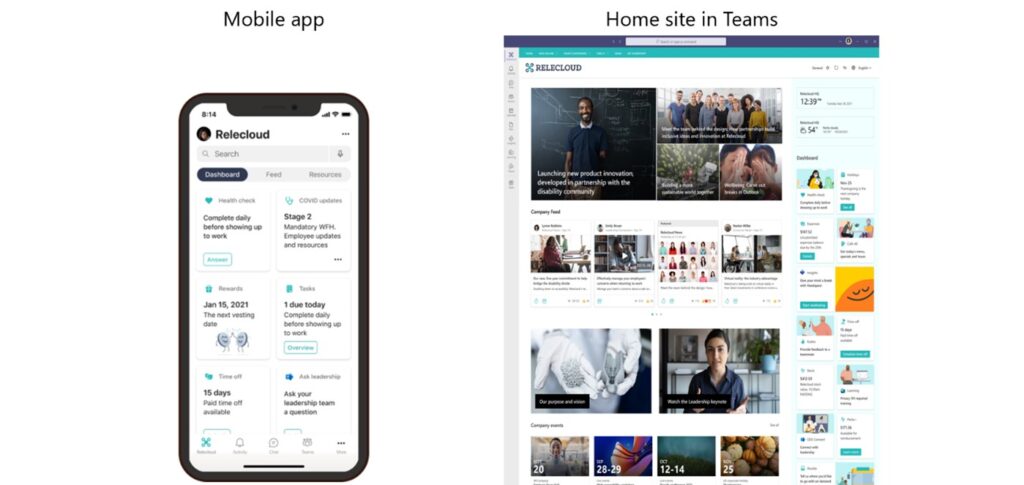
図 4. サンプルの Microsoft Viva コネクション アプリが Teams とモバイル デバイスの両方で実行されています。
"承認" の拡張性
Microsoft Teams の中の "承認" は、現場の最前線で働く従業員からオフィス ワーカーまであらゆる人々が、承認の作成、管理、共有を簡単に、仕事の流れの中で直接行うのに役立ちます。このたび、承認の作成、読み取り、更新、削除 (CRUD) の API を発表します。開発者はこの承認 API を使用して承認機能を基幹業務アプリに取り込むことや、Webhook を使用して Teams の "承認" での変更追跡とワークフロー推進ができるようになります。承認 API は 2022 年中盤にプレビュー開始を予定しています。最新情報については Microsoft Developer Blogs をご覧ください。詳細については、こちらのオンデマンド セッションをご覧ください。
開発者の生産性をスケーリング
ビルド 1 回で Teams と Microsoft 365 のどこにでもデプロイ
本日、新しい Teams SDK の一般提供開始を発表します。これを利用すると Teams、Outlook、Office に対応するアプリを単一のアプリケーション & デプロイメント モデルで構築することや、各製品に関係する機能を活用するコラボレーティブ アプリを構築することができます。開発者は最新の Teams JS SDK v2 とアプリ マニフェスト v1.13 にアップグレードできるようになりました。これで実稼働用の Teams 対応アプリを作成することや、フルスケールのパイロットを Outlook と Office のプレビュー チャネルのユーザーを対象として実施することができます。こうしてフィードバックを集めて、Outlook と Office で動作するアプリの配布 (本年中に可能になる予定です) に備えることができます。
これらの更新には後方互換性があるため、開発済みの Teams 対応アプリはすべて改変不要で今後も Teams の中で動作し、実稼働レベル サポートが受けられます。Teams 開発者向けエクスペリエンス (Microsoft Teams 開発者ドキュメント、ツール、サポート、コード リポジトリなど) は、拡張されたアプリをサポートするように更新されています。シングルテナントとマルチテナントの両方のアプリを、既存の Teams エクスペリエンスを使用して配布できるようになります。詳細については、Teams 対応アプリを Microsoft 365 の他の部分でも利用できるようにすることについてのオンデマンド セッションをご覧ください。

図 5. MURAL の Teams 対応アプリにある個人用タブと検索ベースのメッセージ拡張機能が他の Microsoft ホスト アプリでも利用可能になります。
MURAL はパートナーの中でも早くから、Teams、Outlook、Office をつなぐコネクテッドなエクスペリエンスを実現するアプリを提供しています。上記の例では、MURAL の検索ベースのメッセージ拡張機能が Outlook のメッセージに直接、対話型のアダプティブ カードとして挿入されています。MURAL の他にも Adobe、eCare Vault、go1、monday.com、Polly、ServiceNow、SurveyMonkey、Zoho など多数のパートナーの協力を得てこれらのツールが完成し、このたび一般提供開始となりましたことを Microsoft Build で発表しました。
Teams Toolkit for Visual Studio Code と CLI の一般提供開始
Teams Toolkit for Visual Studio、Visual Studio Code、コマンドライン インターフェイス (CLI) は、Teams と Microsoft 365 のためのアプリを短時間で構築するためのツールです。Teams プラットフォームの経験がない方もベテランの開発者も、Teams Toolkit を使うことがアプリの作成、ビルド、デバッグ、テスト、デプロイの最善の方法です。本日、Teams Toolkit for Visual Studio Code と CLI の一般提供 (GA) 開始を発表します。開発者はシナリオベースのコード スキャフォールドを足掛かりとして通知とコマンド & レスポンスのボットを作成することや、最新バージョンの Teams SDK へのアップグレードを自動化することや、Outlook や Office のアプリを直接デバッグすることができます。Teams Toolkit を使ったアプリ構築は今すぐ始めることができます。
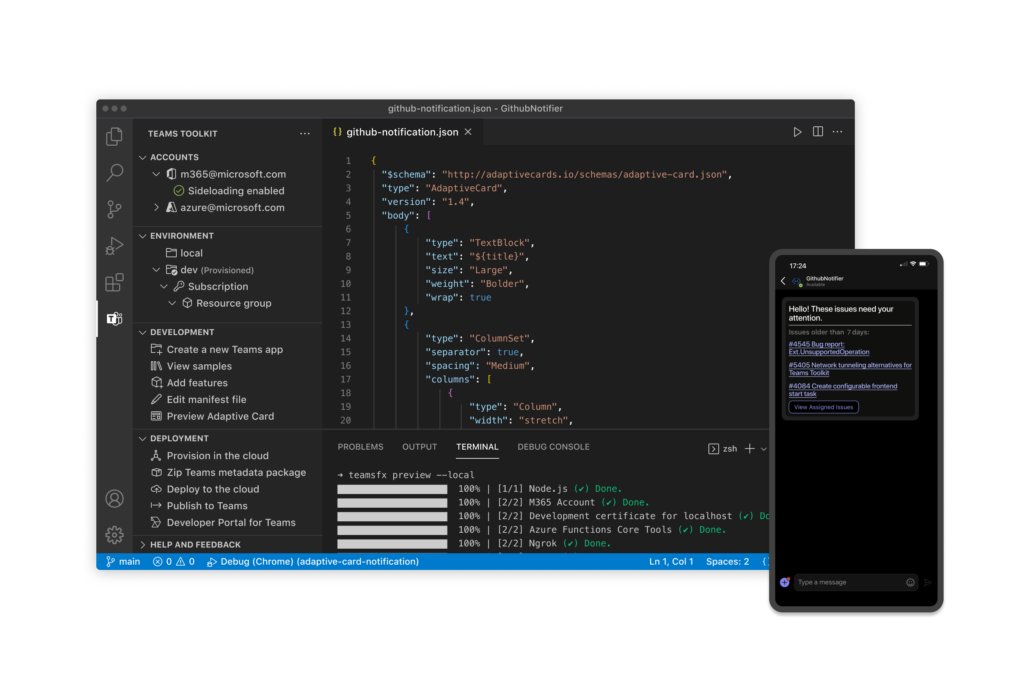
図 6. Microsoft Teams 用の通知アプリを、Teams Toolkit for Visual Studio Code を使用して構築しています。
Power Apps でのコラボレーション コントロール
このたび発表する "Power Apps でのコラボレーション コントロール" は、Power Apps で構築されるカスタム アプリの中から直接 Microsoft 365 のコラボレーション機能 (Teams のチャット、会議、ファイル、Tasks by Planner など) をドラッグ アンド ドロップできるようにするものです。コラボレーション コントロールのプレビュー開始は 2022 年中盤を予定しています。詳細については、こちらのオンデマンド セッションをご覧ください。最新情報については、Power Apps のブログをご覧ください。
開発するアプリでのユーザー エンゲージメントと収益化を成長させる
Microsoft 365 用アプリ コンプライアンス自動化ツール
Microsoft 365 アプリ コンプライアンス プログラムの目的は、アプリケーションがどれだけ信頼できるかを評価して対外的に示すことであり、この基準にはセキュリティ、プライバシー、データ取り扱い方法についての業界標準、たとえば SOC 2、PCI DSS、ISO 27001 などが使用されます。このたび、Microsoft 365 用アプリ コンプライアンス自動化ツールのプレビューを発表します。Azure 上で構築されたアプリケーションが対象であり、アプリのコンプライアンスの行程を加速するのに役立ちます。このツールで、開発者はかなりの数のタスクを自動化できるので、認定を短時間で、簡単に達成できるようになります。このツールにはレポート生成機能もあり、開発者が簡単に共有できるので、IT 部門がアプリのセキュリティとコンプライアンスを可視化するのに役立ちます。詳細については、Docs の Microsoft 365 用アプリ コンプライアンス自動化ツールのページをご覧ください。
アプリの管理と発見しやすさを向上
Teams Store はユーザーが適切なアプリを見つけるのに役立ちます。アプリ カテゴリが更新され、アプリのコレクションがキュレーションされ、人気の注目アプリが一覧表示され、ユーザーの同僚や仲間の使用状況に基づいてインテリジェントにおすすめが提示されます。今年の Microsoft Build では、Teams Store における中央エクスペリエンスを発表します。さまざまな Teams とグループ チャットで使用しているアプリをユーザーが自分で追跡するのに役立つとともに、そのアプリでどのアクセス許可が必要かがわかります。また、タブ、メッセージ拡張機能、コネクタを通したアプリの発見を、コンテキスト重視でできるようにします。これでユーザーが適切なアプリを見つけやすくなり、Teams の中で動作する ISV のアプリの使用を増やすのに役立ちます。たとえば、メッセージの新規作成というコンテキストでは、メッセージ拡張機能からの提案がタスクとアクション別にまとめられ、ユーザーはここから選択して実行できます。最後に、皆さまが開発したアプリをモバイル デバイスのユーザーが直接、たとえばリンクや QR コードから追加できるようになりました。
Teams 対応アプリのアプリ内購入
パートナーと開発者の皆さまからのご要望としてトップに挙げられるものの 1 つが、開発する Teams 対応アプリに課金システムを組み込むことです。これで、無料版アプリをフリーミアム版に転換できるようになり、アプリのユーザーにサブスクリプションで利用するかどうかを尋ねることができます。この新しいアプリ内購入機能は本日から提供を開始し、数行のコードを書くだけで呼び出すことができます。詳細については、Docs のアプリ内購入のページをご覧ください。
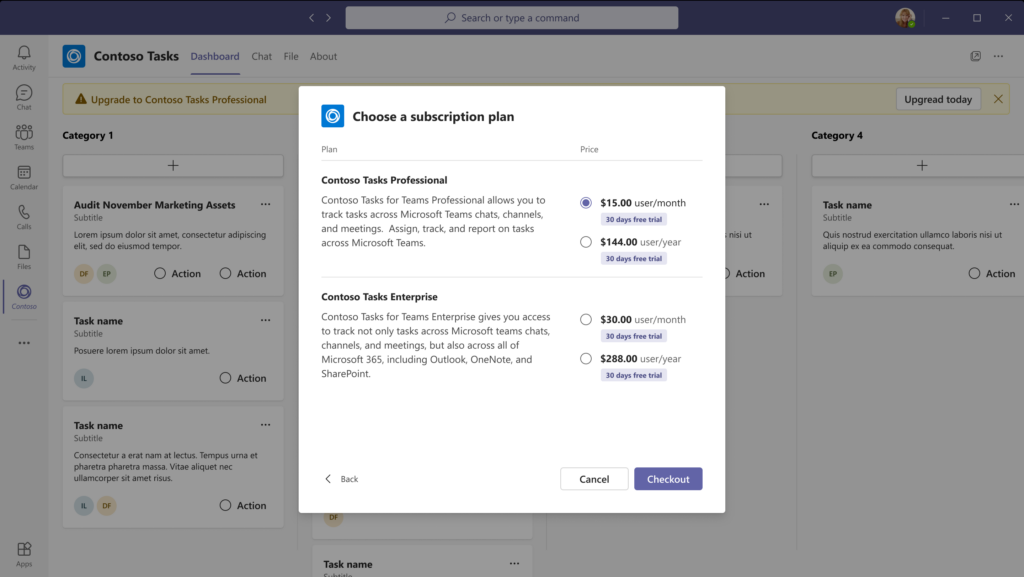
図 7. 数行のコード追加で、フリーミアム アップグレードが Teams の中で直接できるようになります。
Teams アプリ ライセンス管理
もう 1 つ、購入済みライセンスの管理と割り当てをユーザーができるようにするという点でも今回大きく前進しています。以前は、ライセンス管理コンポーネントをソリューションに組み込むかどうかは開発者に任されていました。方法としては、ランディング ページや、アプリの中で直接行うというものがあります。ライセンス管理のエクスペリエンス効率化に役立つように、間もなく、ライセンス管理の負担を開発者から Microsoft に移せるようにします。これで、ユーザーがライセンスの管理と割り当てを Teams の中で直接行うことができます。Teams でのライセンス管理のプレビュー開始は 2022 年中盤を予定しています。
新しいコラボレーティブ アプリが Teams に登場
ISV 各社から、革新的なコラボレーティブ アプリが次々と Teams に登場し、そのシナリオは広範にわたっています。ここでは、本日または近日中に提供を開始する新しいアプリの例をご紹介します。
- MURAL アプリ for Teams は、あらゆる場所のチームが共有コラボレーション スペースを Microsoft Teams に取り込めるようにするものです。ユーザーは非同期の視覚的コラボレーションでチームワークを向上させることができます。エンゲージメントできていない会話を変革して、生産的で全員が積極的に参加できる会議やワークショップにするための多数のテンプレートと、実証済みのガイド付きメソッドが用意されており、チームが画期的な成果を達成するための力となります。MURAL は Microsoft プレビュー パートナーであり、MURAL アプリは Teams、Outlook、Office のすべてで単一のコネクテッド エクスペリエンスとして動作します。
- Observable アプリ for Teams は、企業がそのデータ、コンテキスト、ロジックを 1 つの場所にまとめて、インサイト発見をコラボレーション型で行うとともにデータ駆動の意思決定を組織全体で加速することを可能にします。 Observable の新しい更新プログラムが 2022 年 6 月に予定されており、Observable でのコメントを通してコラボレーションするときに Microsoft Teams 通知を利用できるようになります。
- SAP S/4HANA operational purchaser chatbot は、Microsoft Teams のコラボレーティブ機能を SAP S/4HANA ユーザーが会話型ユーザー エクスペリエンスの中で利用できるようにするものです。これには Microsoft Azure Active Directory (Azure AD) 認証が使用され、Microsoft Graph API が利用されているため、ユーザーが他の関係者を呼び出すことやビジネス パートナーとの Teams 会議のスケジュールを設定することが、認証済みビジネス ユーザーのコンテキストでボットの中から直接できるようになります。これは SAP 内のスタンドアロン アプリの中での Teams のコラボレーション エクスペリエンスの緊密な統合を提供するものであり、ユーザーに必要な接続性とコラボレーションをもたらします。
- ServiceDesk Plus Cloud アプリは Zoho のエンタープライズ IT 管理部門である ManageEngine から提供されています。Microsoft Teams を利用してビジネスと IT のサービス デリバリーを効率化し、IT のインシデント解決を管理してスピードアップし、エンタープライズ全体でサービス エクスペリエンスを向上させます。間もなく、ServiceDesk Plus Cloud アプリの既存の静的なアダプティブ カードが Loop コンポーネントで拡張されます。これで、チケット関連の仕事をする人全員が、最新の更新情報を入手してサービス デスクのタスクをトリガーすることがタブの切り替え不要でできるようになります。
- Figma はコラボレーティブなデザイン プラットフォームですが、ここに導入される新しいアプリで、チームが Figma と FigJam のファイルの共有、プレゼンテーション、コラボレーションをリアルタイムで、Teams 会議の中でできるようになります。このアプリでは新しいアダプティブ カード機能も利用されているため、ユーザーが Figma または FigJam のファイルへのリンクを Teams チャットの中で共有するとカードが展開し、ユーザーがそのファイルを Teams の中から開くことができます。ファイルの通知を見て応答することも、Teams の中から直接行うことができます。Figma アプリは 2022 年中に Teams アプリ ストアでの提供を開始する予定です。
詳細情報
ここでは、Microsoft Teams と Microsoft 365 の上で動作するコラボレーティブ アプリの開発についてさらに学ぶための主なリソースをまとめます。
- コラボレーティブ アプリに関する Microsoft Build での基調講演、ブレークアウト、集中セッションの録画をご覧ください。
- 今回の発表の詳しい内容を Build オンデマンド セッションでご覧ください。
- Microsoft Teams デベロッパー センターにアクセスして、Teams で動作するコラボレーティブ アプリの構築を開始します。
- Microsoft Graph デベロッパー センターにアクセスして、開発するアプリを Microsoft 365 のデータおよび AI と接続します。
- Live Share のブログを読み、このテクノロジと、開発者がこれを使用してできることについてさらに詳しく学びます。
- ローコードを再定義する Power Platform の新しい製品と機能についての Charles Lamanna によるブログをご覧ください。
- Microsoft 365 ISV プログラムに参加すると 1 対 1 のサポートなどの特典を利用できます。





